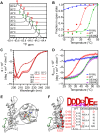Switchable client specificity in a dual functional chaperone coordinates light-harvesting complex biogenesis
- PMID: 40512866
- PMCID: PMC12164976
- DOI: 10.1126/sciadv.adu5791
Switchable client specificity in a dual functional chaperone coordinates light-harvesting complex biogenesis
Abstract
The proper assembly of light-harvesting complexes (LHCs) is critical for photosynthesis and requires the biogenesis of light-harvesting chlorophyll a,b-binding proteins (LHCPs) to be coordinated with chlorophyll (Chl) biosynthesis. The mechanism underlying this coordination is not well understood. Here, we show that a conserved molecular chaperone, chloroplast signal recognition particle 43-kDa protein (cpSRP43), provides a molecular thermostat that helps maintain this coordination. cpSRP43 undergoes a conformational rearrangement between a well-folded closed state and a partially disordered open state. Closed cpSRP43 is dedicated to the biogenesis of LHCPs, whereas open cpSRP43 protects multiple Chl biosynthesis enzymes from heat-induced destabilization. Rising temperature shifts cpSRP43 to the open state, enabling it to protect heat-destabilized Chl biosynthesis enzymes. Our results reveal the molecular basis of a posttranslational mechanism for the thermoadaptation of LHC biogenesis. They also demonstrate how an adenosine triphosphate-independent chaperone uses conformational dynamics to switch its activity and client selectivity, thereby adapting to different proteostatic demands under shifting environmental conditions.
Figures







Similar articles
-
Chloroplast SRP43 acts as a chaperone for glutamyl-tRNA reductase, the rate-limiting enzyme in tetrapyrrole biosynthesis.Proc Natl Acad Sci U S A. 2018 Apr 10;115(15):E3588-E3596. doi: 10.1073/pnas.1719645115. Epub 2018 Mar 26. Proc Natl Acad Sci U S A. 2018. PMID: 29581280 Free PMC article.
-
Conformational dynamics of a membrane protein chaperone enables spatially regulated substrate capture and release.Proc Natl Acad Sci U S A. 2016 Mar 22;113(12):E1615-24. doi: 10.1073/pnas.1524777113. Epub 2016 Mar 7. Proc Natl Acad Sci U S A. 2016. PMID: 26951662 Free PMC article.
-
Chloroplast SRP43 autonomously protects chlorophyll biosynthesis proteins against heat shock.Nat Plants. 2021 Oct;7(10):1420-1432. doi: 10.1038/s41477-021-00994-y. Epub 2021 Sep 2. Nat Plants. 2021. PMID: 34475529 Free PMC article.
-
Organization of chlorophyll biosynthesis and insertion of chlorophyll into the chlorophyll-binding proteins in chloroplasts.Photosynth Res. 2015 Dec;126(2-3):189-202. doi: 10.1007/s11120-015-0154-5. Epub 2015 May 9. Photosynth Res. 2015. PMID: 25957270 Review.
-
Structure and function of the chloroplast signal recognition particle.Curr Genet. 2004 Jan;44(6):295-304. doi: 10.1007/s00294-003-0450-z. Epub 2003 Oct 21. Curr Genet. 2004. PMID: 14569414 Review.
References
-
- Jarvis P., López-Juez E., Biogenesis and homeostasis of chloroplasts and other plastids. Nat. Rev. Mol. Cell Biol. 14, 787–802 (2013). - PubMed
-
- Dall’Osto L., Bressan M., Bassi R., Biogenesis of light harvesting proteins. Biochim. Biophys. Acta Bioenerg. 1847, 861–871 (2015). - PubMed
-
- Paulsen H., Finkenzeller B., Kühlein N., Pigments induce folding of light-harvesting chlorophyll a/b-binding protein. Eur. J. Biochem. 215, 809–816 (1993). - PubMed
MeSH terms
Substances
LinkOut - more resources
Full Text Sources

